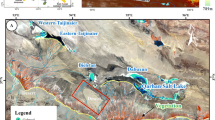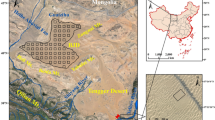Abstract
In terms of formation mechanisms of linear dunes, there are open arguments for their widespread distribution and multi-morphological diversities. In order to clarify the formation mechanism of linear dunes of Qarhan Salt Lake, we used pattern analysis method to analyze the statistical characteristics and spatial variation of their pattern parameters. Except at the west-northwest margin, the pattern parameters showed regular spatial variation from the up-middle part towards the downwind end of the dune field. Based on the cumulative probability plots for inter-crest spacing and crest length, we divided the linear dunes into three groups, which corresponding to the three evolution stages of these dunes. The first group comprises erosional relics, with shorter crests, smaller inter-crest spacing and more random dune orientation. The second group comprises dunes whose sand supply is just sufficient to maintain stability and these dunes are approaching the net erosion stage. The crest length and inter-crest spacing of these dunes are much larger than those of the first group, and dune orientation is closer to the resultant drift direction (RDD). The last group comprises linear dunes that are still undergoing vertical accretion and longitudinal elongation, which follows the RDD of the modern wind regime. The presence of regular spatial variation of pattern parameters and a similar geometry with the vegetated linear dunes suggest that deposition and erosion coexist in the development and evolution of linear dunes of Qarhan Salt Lake, i.e. deposition predominates at the downwind end of linear dunes in the vertical accretion and longitudinal elongation stage, whereas erosion mainly occurs at the upwind end of linear dunes in the degradation stage. Therefore, the formation mechanism of linear dunes in Qarhan Salt Lake can be reasonably explained by the combination of depositional and erosional theories.
Similar content being viewed by others
References
Beveridge C, Kocurek G, Ewing R C, et al. 2006. Development of spatially diverse and complex dune-field patterns: Gran Desierto Dune Field, Sonora, Mexico. Sedimentology, 53(6): 1391–1409.
Derickson D, Kocurek G, Ewing R C, et al. 2008. Origin of a complex and spatially diverse dune-field pattern, Algodones, southeastern California. Geomorphology, 99(1–4): 186–204.
Dong Z B, Su Z Z, Qian G Q, et al. 2011. Aeolian Geomorphology of the Kumtagh Desert. Beijing: Science Press, 354–369. (in Chinese)
Edgett K S, Blumberg D G. 1994. Star and linear dunes on Mars. Icarus, 112(2): 448–464.
Ewing R C, Kocurek G, Lake L W. 2006. Pattern analysis of dune-field parameters. Earth Surface Processes and Landforms, 31(9): 1176–1191.
Ewing R C, Kocurek G A. 2010. Aeolian dune interactions and dune-field pattern formation: White Sands Dune Field, New Mexico. Sedimentology, 57(5): 1199–1219.
Ewing R C, Peyret A P B, Kocurek G, et al. 2010. Dune field pattern formation and recent transporting winds in the Olympia Undae Dune Field, north polar region of Mars. Journal of Geophysical Research, 115(E8): E08005, doi: 10.1029/2009JE003526.
Ewing R C, Hayes A G, Lucas A. 2015. Sand dune patterns on Titan controlled by long-term climate cycles. Nature Geoscience, 8(1): 15–19.
Fryberger S G, Dean G. 1979. Dune forms and wind regime. In: McKee E D. A Study of Global Sand Seas. United States Geological Survey Professional Paper 1052. Hawaii: University Press of the Pacific, 137–169.
Hallet B. 1990. Spatial self-organization in geomorphology: From periodic bedforms and patterned ground to scale-invariant topography. Earth-Science Reviews, 29(1–4): 57–75.
Herrmann H J, Durán O, Parteli E J R, et al. 2008. Vegetation and induration as sand dunes stabilizators. Journal of Coastal Research, 24(6): 1357–1368.
Hesp P A, Hyde R, Hesp V, et al. 1989. Longitudinal dunes can move sideways. Earth Surface Processes and Landforms, 14(5): 447–451.
Kocurek G, Ewing R C. 2005. Aeolian dune field self-organization—implications for the formation of simple versus complex dune-field patterns. Geomorphology, 72(1–4): 94–105.
Lancaster N. 1995. Geomorphology of Desert Dunes. London: Routledge, 48–56.
Lancaster N, Kocurek G, Singhvi A, et al. 2002. Late Pleistocene and Holocene dune activity and wind regimes in the western Sahara Desert of Mauritania. Geology, 30(11): 991–994.
Lancaster N. 2006. Linear dunes on Titan. Science, 312(5774): 702–703.
Lee P, Thomas P C. 1995. Longitudinal dunes on Mars: Relation to current wind regimes. Journal of Geophysical Research, 100(E3): 5381–5395.
Li J Y, Dong Z B, Qian G Q, et al. 2016. Yardangs in the Qaidam Basin, northwestern China: Distribution and morphology. Aeolian Research, 20: 89–99.
Lorenz R D, Wall S, Radebaugh J, et al. 2006. The sand seas of Titan: Cassini RADAR observations of longitudinal dunes. Science, 312(5774): 724–727.
McKee E D. 1979. Introduction to a study of global sand seas. In: McKee E D. A Study of Global Sand Seas. United States Geological Survey Professional Paper 1052. Hawaii: University Press of the Pacific, 1–19.
Petrov M P. 1976. Deserts of the World. New York: John Wiley & Sons.
Qian G Q, Dong Z B, Zhang Z C, et al. 2012. Granule ripples in the Kumtagh Desert, China: Morphology, grain size and influencing factors. Sedimentology, 59(6): 1888–1901.
Qian Z Y. 1986. Investigations on the sand harm to Qinghai-Xizang railway in Yanqiao area and sand control plan. Journal of Desert Research, 6(2): 27–30. (in Chinese)
Qian Z Y, Liu S Q. 1994. Research on aeolian sand characteristics and depositional structures of linear dunes. Journal of Desert Research, 14(3): 25–30. (in Chinese)
Rubin D M, Hunter R E. 1987. Bedform alignment in directionally varying flows. Science, 237(4812): 276–278.
Rubin D M, Hesp P A. 2009. Multiple origins of linear dunes on Earth and Titan. Nature Geoscience, 2(9): 653–658.
Rubin D M, Rubin A M. 2013. Origin and lateral migration of linear dunes in the Qaidam Basin of NW China revealed by dune sediments, internal structures, and optically stimulated luminescence ages, with implications for linear dunes on Titan: discussion. Geological Society of America Bulletin, 125(11–12): 1943–1946.
Tsoar H, Møller J T. 1986. The role of vegetation in the formation of linear sand dunes. In: Nickling W G. Aeolian Geomorphology. Boston: Allen & Unwin, 75–95.
Wang X M, Dong Z B, Yan P, et al. 2005. Wind energy environments and dunefield activity in the Chinese deserts. Geomorphology, 65(1–2): 33–48.
Werner B T. 1995. Eolian dunes: computer simulations and attractor interpretation. Geology, 23(12): 1107–1110.
Werner B T, Kocurek G. 1997. Bed-form dynamics: Does the tail wag the dog?. Geology, 25(9): 771–774.
Werner B T. 1999. Complexity in natural landform patterns. Science, 284(5411): 102–104.
Werner B T, Kocurek G. 1999. Bedform spacing from defect dynamics. Geology, 27(8): 727–730.
Wiggs G F S, Thomas D S G, Bullard J E, et al. 1995. Dune mobility and vegetation cover in the Southwest Kalahari desert. Earth Surface Processes and Landforms, 20(6): 515–529.
Wu J F, Guo F. 2012. Geomorphological patterns in a linear dune field and ages of the linear dunes in the northern Kumtagh Desert, northwest China. Environmental Earth Sciences, 66(8): 2449–2457.
Yu L P, Dong Z B, Lai Z P, et al. 2015. Origin and lateral migration of linear dunes in the Qaidam Basin of NW China revealed by dune sediments, internal structures, and optically stimulated luminescence ages, with implications for linear dunes on Titan: comment and discussion. Geological Society of America Bulletin, 127(1–2): 316–320.
Zhou J, Zhu Y, Yuan C. 2012. Origin and lateral migration of linear dunes in the Qaidam Basin of NW China revealed by dune sediments, internal structures, and optically stimulated luminescence ages, with implications for linear dunes on Titan. Geological Society of America Bulletin, 124(7–8): 1147–1154.
Zhou J, Zhu Y, Yuan C. 2013. Origin and lateral migration of linear dunes in the Qaidam Basin of NW China revealed by dune sediments, internal structures, and optically stimulated luminescence ages, with implications for linear dunes on Titan: reply. Geological Society of America Bulletin, 125(11–12): 1947–1949.
Author information
Authors and Affiliations
Corresponding author
Rights and permissions
About this article
Cite this article
Li, J., Dong, Z., Qian, G. et al. Pattern analysis of a linear dune field on the northern margin of Qarhan Salt Lake, northwestern China. J. Arid Land 8, 670–680 (2016). https://doi.org/10.1007/s40333-016-0052-5
Received:
Revised:
Accepted:
Published:
Issue Date:
DOI: https://doi.org/10.1007/s40333-016-0052-5




